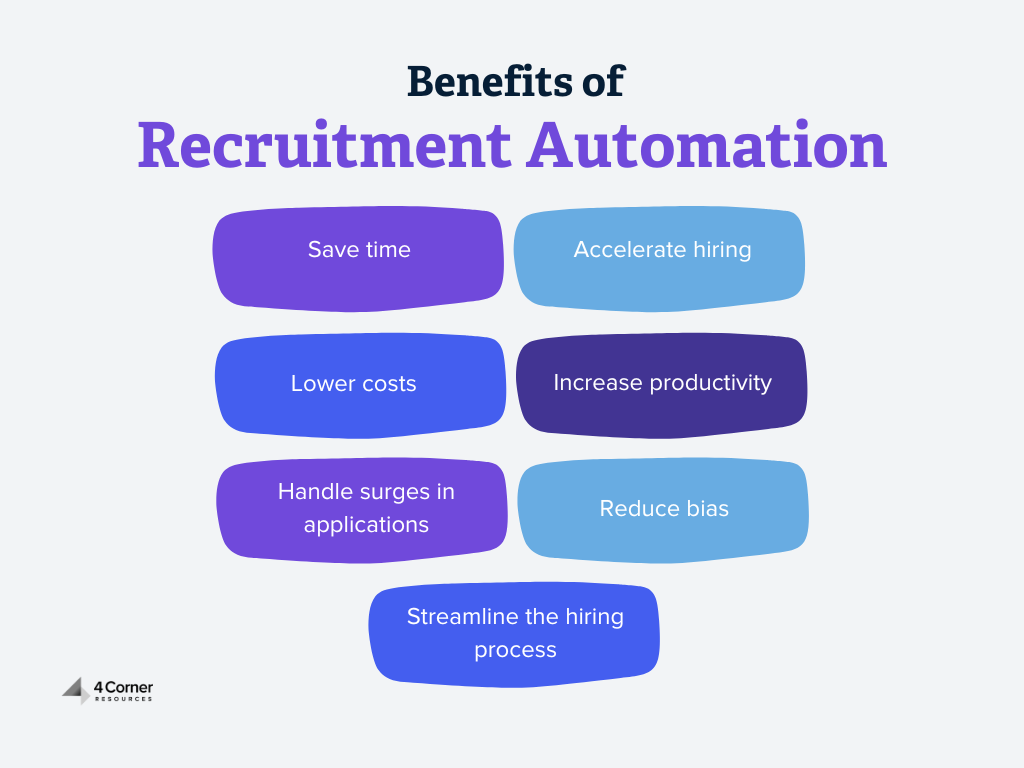What Is Recruitment Automation and How Can You Use It to Hire Smarter?

Recruitment automation has the power to free up hours in your week while helping you hire great candidates faster. Best of all, it’s something any company can take advantage of. If offloading tedious tasks and lowering your recruiting costs sounds appealing, read on to learn what recruitment automation is and how to use it to hire smarter.
What Is Recruitment Automation?
Recruitment automation is the process of using technology to tackle talent acquisition and hiring tasks automatically. Companies use recruitment automation to save time, hire faster, increase recruiter productivity, and reduce hiring expenses. It can also lead to a better candidate experience, which contributes to the larger goal of hiring the best talent available.
In a world where employees–recruiting staff included–are being asked to do more with less, recruitment automation helps keep your talent pipeline moving while ensuring that nothing falls through the cracks.
Recruitment automation might sound advanced, but modern applications make it easily accessible for pretty much any recruiter with a computer and an internet connection to take advantage of. You might even have some automation tools already available to you in your existing applicant tracking system.
How Do You Automate Recruiting?
The best way to automate your recruiting processes is to think about your overall talent pipeline. Break it into phases–what steps does every candidate go through before (and even after) being hired?
For each phase, assess the activities that happen on the recruiter’s end, along with activities that require action from other team members. This can be helpful to think of in terms of cause and effect. For example:
Application comes in → Recruiter opens and reviews it
Candidate passes initial screening → Recruiter reaches out to schedule interview
Candidate moves to second interview → Recruiter sends skills assessment
For each of these cause-effect scenarios, there’s a task that can be automated, removing it from the recruiter’s to-do list while keeping the hiring process moving smoothly.
Related: Can You Trust AI to Handle Recruitment?
Here are some useful examples of how you can automate recruiting processes.
Post job openings
Posting to multiple job boards is incredibly time-consuming. Use a tool that integrates with your human resource information system (HRIS) software to automatically pull required fields from approved requisitions and post them to all of the major job platforms, like Indeed and LinkedIn.
Screen for qualified applicants
AI is a powerful solution for tackling the heavy lifting of initial screening. Learning models can compare candidate applications against the criteria within the job posting and determine whether a candidate meets the minimum requirements. If so, it can forward the application to human hiring managers. If not, it can trigger a sequence of events like sending a rejection notification and updating the candidate’s status in your ATS.
Ask for employee referrals
One of the most functional ways to automate recruitment processes is to leverage team communication platforms where employees spend a lot of time, like Slack. Set up an automation so that as soon as a new opening is approved by HR or added to your careers page, a message is sent out on your team-wide Slack channel prompting employees to refer people who would be a good fit.
Schedule interviews
One of the easiest and most impactful recruitment automations you can implement is scheduling interviews with qualified candidates automatically. Once a candidate’s status has been updated in your ATS, you can leverage an integration with your team’s calendar tool to find appropriate times for each interviewer and email the applicant an invitation.
Send reminders
Use automation to send timely reminders about important steps in the hiring process, like interviews. For example, you can greatly reduce missed appointments by sending a reminder to both the interviewer and the interviewee 24 hours in advance. You can also use reminders to accelerate hiring and promote accuracy by prompting hiring managers to complete candidate scoring sheets immediately after an interview ends.
Check off pre-hire requirements
The great thing about automation is that it allows the disparate tools you already use for your hiring processes to work together seamlessly. One such integration can happen with pre-hire processes like skills assessments and background checks. Once a candidate has been given a certain status in your ATS, you can automatically trigger a platform like Checkr to complete a background check or TestGorilla to administer a skills assessment.
Collect candidate feedback
Candidate feedback surveys can dramatically improve your hiring efforts. Use automation to send them at a preselected interval, like seven days after a hiring decision has been made.
Benefits of Automating Recruiting Tasks

Save time
If it’s a task recruiting staffers do five or more times a day, chances are it can and should be automated. Repetitive tasks eat up minutes here and there that could be better spent on higher-value activities, like having one-on-one conversations with candidates.
Accelerate hiring
When you’re juggling multiple candidates for multiple open positions, it’s easy to lose track of where everyone stands in the hiring process. These days, good candidates are snatched up fast, so a delay of even a day or two could cost you a great hire. Recruitment automation keeps up the forward momentum and automates the process of following up with candidates, so you’re never the bottleneck in your pipeline.
Lower costs
Hiring faster contributes to lower hiring costs. And, because you’re merely using technology to automate tasks rather than eliminating steps to cut corners, there’s no corresponding drop in the quality of candidates.
Keep rising costs from getting you down with our ‘Reducing Labor Costs’ eBook.
Learn from our experts on how to streamline your hiring process.
Increase productivity
When recruiters have fewer tedious tasks to deal with, they have more energy for tasks that require heavier lifting, mentally speaking. They can get more done in the same number of hours–and are happier, too.
Handle surges in applications
When unemployment is high, sorting through the mountain of applications for each open position can be overwhelming. Recruitment automation can help put order to the chaos and ensure qualified candidates aren’t overlooked.
Reduce bias
The more humans involved in a process, the more bias is inherently involved. Removing some of the human element from your hiring tasks can help reduce bias that can unintentionally creep in.
Related: Beware of These Subconscious Hiring Biases
Streamline the hiring process
Recruitment automation ensures that each step in the hiring process flows smoothly into the next, like clockwork. These are the kinds of small details top candidates pick up on, and they contribute to a better overall candidate experience.
Examples of Automated Recruitment Tools
Automation is everywhere. You may already be taking advantage of some of these tools without even realizing it. Here are a few examples:
- Applicant tracking systems, which automatically track candidate and recruiter activity throughout the hiring process. These are one of the most widely used automation tools, offering useful features to help recruiters stay on top of tasks.
- AI-powered chatbots on a company’s careers page that answer frequently asked questions about jobs and gather basic information from prospective candidates.
- Social media publishing tools help companies push out regularly scheduled content that strengthens their employer brand.
- Interview scheduling tools that automatically contact desired candidates. Candidates are shown available time frames and can choose the one that suits them best, eliminating back-and-forth with one or more interviewers.
- Email nurturing sequences that follow up with candidates after they’ve submitted an application or signed up to receive job alerts.
- Text message alerts that prompt candidates to finish submitting application materials or complete skills assessments.
- Programmatic advertising, which automates the process of buying and publishing job listing ads.
These are just a few of the many ways forward-thinking recruiters can leverage automation to enhance their efforts.
Related: The Pros and Cons of Applicant Tracking Systems
How to Start Using Recruitment Automation
Assess your recruiting activities
As we touched on earlier, assessing the activities that take place during each stage of your hiring process is a crucial first step. A time-tracking tool can be useful for quantifying the amount of time dedicated to different tasks. What are recruiters spending the most time on? Which of these tasks are good candidates for automation?
Ready to hire someone great?
Speak with our recruiting professionals today.
Start small
You don’t need to build an automated recruitment machine overnight. Instead, pick one or two of the most time-consuming yet low-level tasks to automate first, then build from there. This can make a dramatic impact over several months.
Leverage existing technology
Before investing in a suite of fancy new software, analyze the technology already available to you. Your ATS likely offers at least some automation features. Are you using them all to their full potential? If you’re unsure, a consultation with your ATS provider is likely in order.
Common Misconceptions of Recruitment Automation
Automation is time-consuming and expensive
If you’re not currently using recruitment automation on a widespread scale, it might be because you’re wary of the expense or the initial time investment it will take to get started. However, modern automation tools are simple and lightweight. Many of them are free and can be implemented in literal minutes.
Remember, automation isn’t all or nothing. You can start by automating a single process and build from there as your team adapts to the adjusted workflow.
Automation is only for big companies
On the contrary, we’d argue that small companies with limited resources stand to gain the most from recruitment automation. Even if hiring is managed by just one or two people, automation can help them offload routine tasks and free up more time to spend interfacing with candidates.
Automation will replace human recruiters
While automation can do a lot, it can’t replace the human touch required to select and hire excellent employees. What it can do is tackle the tasks that don’t require human input so that recruiters can spend their time on recruitment strategy, messaging, and face-to-face interactions. Human oversight is also required to ensure systems are working as intended, like fine-tuning the training of AI models used to select the right candidates.
Candidates dislike an automated experience
It’s important to differentiate between canned, generic auto-response emails (which are the type of thing candidates hate) and well-executed automation strategies. One major pain point in the candidate experience is long lapses of time between updates on the position. Automation can easily resolve this issue by sending regular status updates, keeping candidates informed, and improving their experience. It’s all about tailoring your automation so that it’s not just time-saving but personal and relevant to the candidate involved.
Enlist Expert Help
If you’re a large company, you might have the bandwidth to set up recruitment automation on your own. If not, you can reap the benefits of automation while also having the advantage of a personal, expert touch by working with a team of recruiting experts like the staffing professionals at 4 Corner Resources.
We help companies of all sizes deploy hiring strategies to find better candidates and hire the best fit for the job. Because hiring is our core competency, we’re proficient with the most cutting-edge recruiting technology and help our clients use it to hire faster, smarter, and at a lower cost.
Get in touch to discuss your hiring needs by contacting us now!
